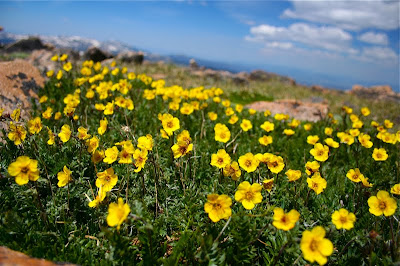On our second full day in Nova Scotia we headed off to the prime tourist attraction of Peggy's Cove, the most photographed spot in the province. Since we lingered on the front porch until almost 11AM, we decided to take the inland highway (103) to exit 5 and then cut in on the coastal route (333). There is a visitor's center near the turn off for 333 that is worth stopping for. There is also a very large grocery store. Had we known about the small size of Lunenburg's stores, we would have stocked up. We asked the docent at the Visitor's Center about food farther down and she said there was a great place at Peggy's Cove itself and not to worry. We should have worried! Pack a lunch if you go to Peggy's Cove!
The drive down 333 was our first realization that these scenic coastal roads can be entirely in the trees. We were almost to the Cove before we could see the sea.
Two kilometers west of the Cove is a pull off for the Swissair Memorial. This short walk was delightful. In 1998 and MD-11 aircraft crashed off the coast killing all 229 aboard. The memorial itself is tasteful but the views from the trail are what drew me.
From the memorial site, the unique geology of the area is readily seen. Like Blue Rocks, the area around Peggy's cove has been greatly affected by glaciation. The stark granite and dramatic coastline is the result of glaciers ripping away all the topsoil as they lumbered southward from the Arctic. The numerous boulders that dot the area, called glacial erratics, were carried by the glacier and deposited there as the glacier receded. They reminded me of Jimmies on top of a child's cupcake. You can also see Peggy's Cove in the distance, but the day we went it was slightly hazy and Peggy's Cove was obscured. Unfortunately, there is no trail beyond the memorial through this very interesting area.
The village of Peggy's Cove is quaint, but after seeing Blue Rocks the night before, we were less impressed. This had less to do with the area and more to do with the miles of cars and "hordes" of tourists scurrying to and fro. We decided to drive up to the lighthouse itself rather than park down by the visitor's center. It costs $5 to park at the lighthouse, which is refunded if you buy something in the gift shop or restaurant. Since it was our intent to eat lunch there we did not have any issues with this.
Since it was 1PM and we were starving, we made a bee-line for the restaurant. Enter disappointment. The place was mobbed, there was a long line to get in, and the prices were tourist-trap exorbitant. We decided to starve a little longer and bought a box of maple cookies in the gift shop, which we ate out on the rocks. After walking around for 15 minutes or so, snapping the obligatory pictures, we decided to head further down highway 333 to escape the crowds. This was a good choice.
A little ways beyond Peggy's Cove toward Halifax is West Dover. This quiet village had a decent restaurant right on the water. We pounced with grumbling stomachs. Sitting out on the deck with its colorful umbrellas we ate fish and chips and drank beer and congratulated ourselves on our good fortune.
Quite thirsty we pulled into Chester looking for a cafe to wet our whistle. At 2pm in the afternoon the microscopic town was closed down except for the pub. We grabbed a soda to go there and continued on our way.
 The view from the deck of the restaurant in West Dover. A much nicer atmosphere than the crowded tourist trap at Peggy's Cove.
The view from the deck of the restaurant in West Dover. A much nicer atmosphere than the crowded tourist trap at Peggy's Cove.The farther away we got from the exposed Atlantic coastline the hotter it became. By the time we reached Mahone Bay it was stifling and we had no desire to get out of the car and walk around. I took a quick photo of the much talked about church and jumped quickly back into the air conditioned car.
At this point the sun was setting and our predictable stomachs were talking to us again so we boogied back to Lunenburg in search of sustenance.
The drive from Peggy's Cove to Lunenburg was not as exciting as the guide book would lead one to believe. We found places to stop for photographs few and far between and more trees than we anticipated.


























































